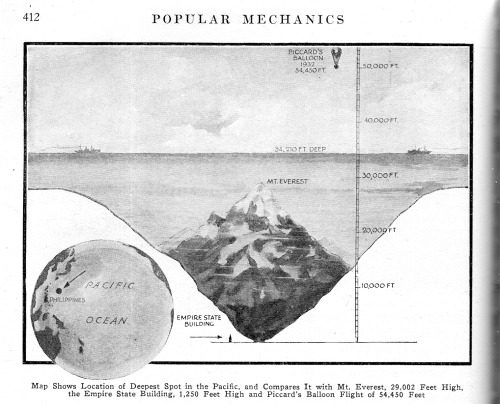JF Ptak Science Books Post 2465
I was just looking for a good link for the full text of Donald Knuth's 1965 paper on "Very Magic Squares" when instead I found mention of his earliest publication, a playful paper that was published in MAD magazine in issue #33 for June 1957. The work by the 19-year-old Knuth, "The potrzebie system of weights and measures", suggested that, among other things, the "potrzebie" as a standard unit of measure--and that was equal to the width of the issue #33 or 2.263348517438173216473. There were more fanciful measures for Knuth, which suggests that these "standard" units are infinite, one measure of infinite being the length of the finite over its negative.
This brings us to measuring things in terms of units of Mt. Everests found in this short notice in Popular Mechancis for September 1933. Truthfully this is a simple dataviz tool, comparing the depth of one unknown and not visualized entity--in this case, the "deepest spot in the Pacific"--with another that is known and highly visible (after a fashion), and so we get to appreicate the great depth by comparing it to Mt. Everest. There are no stackings of Everests in this image though I can see a future use for the visual--I have after all posted many unusual pieces to this blog where heights/depths are measured in terms of stacks of Eiffel Towers, or mammoth bread, or gigantic piles of wood, or nails, and uprighted ships, and of course numerous Great Pyramids filled with excavated dirt from the digging of the Panama Canal and stretched over the island of Manhattan. Those are more involved, while the present unit of measure is just suggesting itself for future use.
On the other hand it might be more beneficial to use stacks of the Empire State Building to convey the sense of deep depth. In 1933 it was just two years old and a world-wide sensation as an icon art deco building and the tallest building in the world, so if you said that the deepest depth could absorb 32 Empire State Buildings one on top of the other, there may have been a greater understanding of the consequences of that much depth. In any event, I like that more as a unit of measure.
Notes:
Knuth. Selected Papers on Fun and Games, http://www-cs-faculty.stanford.edu/~uno/fg.html (From the website: "I've never been able to see any boundary between scientific research and game-playing. ... The topics treated here were often inspired by patterns that are visually compelling, or by paradoxical truths that are logically compelling, or by combinations of numbers and/or symbols that fit together just right. These were papers that I couldn't not write.)
Knith's c.v. http://www-cs-faculty.stanford.edu/~uno/vita.html




Comments